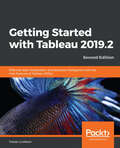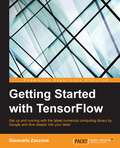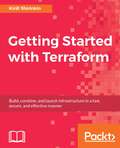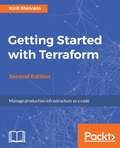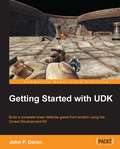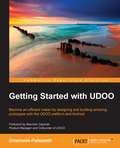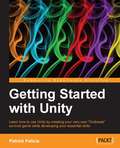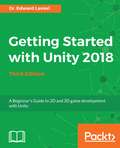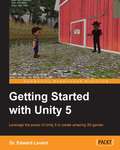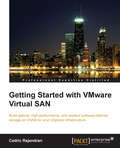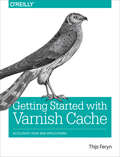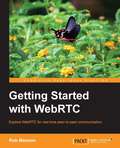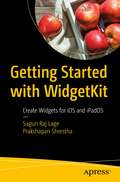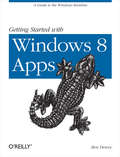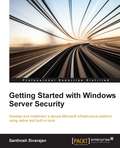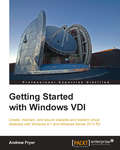- Table View
- List View
Getting Started with Tableau 2019.2: Effective data visualization and business intelligence with the new features of Tableau 2019.2, 2nd Edition
by Tristan GuillevinLeverage the power of Tableau 2019.1’s new features to create impactful data visualizationKey FeaturesGet up and running with the newly released features of Tableau 2019.1Create enterprise-grade dashboard and reports to communicate your insights effectivelyBegin your Tableau journey by understanding its core functionalitiesBook DescriptionTableau is one of the leading data visualization tools and is regularly updated with new functionalities and features. The latest release, Tableau 2019.1, promises new and advanced features related to visual analytics, reporting, dashboarding, and a host of other data visualization aspects. Getting Started with Tableau 2019.1 will get you up to speed with these additional functionalities.The book starts by highlighting the new functionalities of Tableau 2019.1, providing concrete examples of how to use them. However, if you're new to Tableau, don’t worry – you’ll be guided through the major aspects of Tableau with relevant examples. You'll learn how to connect to data, build a data source, visualize your data, build a dashboard, and even share data online. In the concluding chapters, you'll delve into advanced techniques such as creating a cross-database join and data blending.By the end of this book, you will be able to use Tableau effectively to create quick, cost-effective, and business-efficient Business Intelligence (BI) solutions.What you will learnDiscover new functionalities such as ‘Ask Data’, the new way to interact with your data using natural languageConnect tables and make transformations such as pivoting the field and splitting columnsBuild an efficient data source for analysisDesign insightful data visualization using different mark types and propertiesDevelop powerful dashboards and stories Share your work and interact with Tableau ServerUse Tableau to explore your data and find new insightsExplore Tableau's advanced features and gear up for upcoming challengesWho this book is forExisting Tableau users and BI professionals who want to get up to speed with what's new in Tableau 2019 will find this beginner-level book to be a very useful resource. Some experience of Tableau is assumed, however, the book also features introductory concepts, which even beginners can take advantage of.
Getting Started with Taipy: The definitive guide to creating production-ready Python applications for data professionals
by Eric NarroShare your machine learning models, create chatbots, as well as build and deploy insightful dashboards speedily using Taipy with this hands-on book featuring real-world application examples from multiple industries Free with your book: DRM-free PDF version + access to Packt's next-gen Reader*Key FeaturesCreate visually compelling, interactive data applications with TaipyBring predictive models to end users and create data pipelines to compare scenarios with what-if analysesGo beyond prototypes to build and deploy production-ready applications using the cloud provider of your choicePurchase of the print or Kindle book includes a free PDF eBook in full colorBook DescriptionWhile data analysts, data scientists, and BI experts have the tools to analyze data, build models, and create compelling visuals, they often struggle to translate these insights into practical, user-friendly applications that help end users answer real-world questions, such as identifying revenue trends, predicting inventory needs, or detecting fraud, without wading through complex code. This book is a comprehensive guide to overcoming this challenge. This book teaches you how to use Taipy, a powerful open-source Python library, to build intuitive, production-ready data apps quickly and efficiently. Instead of creating prototypes that nobody uses, you'll learn how to build faster applications that process large amounts of data for multiple users and deliver measurable business impact. Taipy does the heavy lifting to enable your users to visualize their KPIs, interact with charts and maps, and compare scenarios for better decision-making. You’ll learn to use Taipy to build apps that make your data accessible and actionable in production environments like the cloud or Docker. By the end of this book, you won’t just understand Taipy, you'll be able to transform your data skills into impactful solutions that address real-world needs and deliver valuable insights. *Email sign-up and proof of purchase requiredWhat you will learnExplore Taipy, its use cases, and how it's different from other projectsDiscover how to create visually appealing interactive apps, display KPIs, charts, and mapsUnderstand how to compare scenarios to make better decisionsConnect Taipy applications to several data sources and servicesDevelop apps for diverse use cases, including chatbots, dashboards, ML apps, and mapsDeploy Taipy applications on different types of servers and servicesMaster advanced concepts for simplifying and accelerating your development workflowWho this book is forIf you’re a data analyst, data scientist, or BI analyst looking to build production-ready data apps entirely in Python, this book is for you. If your scripts and models sit idle because non-technical stakeholders can’t use them, this book shows you how to turn them into full applications fast with Taipy, so your work delivers real business value. It’s also valuable for developers and engineers who want to streamline their data workflows and build UIs in pure Python.
Getting Started with Talend Open Studio for Data Integration
by Jonathan BowenGetting Started with Talend Open Studio for Data Integration takes a step-by-step, hands-on approach to learning with lots of examples and clear instructions. Are you a developer, business analyst, project manager, business intelligence specialist, system architect or a consultant who needs to undertake integration projects, then this book is for you. The book assumes a certain level of familiarity with Relational database management systems with SQL and experience and Java.
Getting Started with TensorFlow
by Giancarlo ZacconeGet up and running with the latest numerical computing library by Google and dive deeper into your data! About This Book * Get the first book on the market that shows you the key aspects TensorFlow, how it works, and how to use it for the second generation of machine learning * Want to perform faster and more accurate computations in the field of data science? This book will acquaint you with an all-new refreshing library--TensorFlow! * Dive into the next generation of numerical computing and get the most out of your data with this quick guide Who This Book Is For This book is dedicated to all the machine learning and deep learning enthusiasts, data scientists, researchers, and even students who want to perform more accurate, fast machine learning operations with TensorFlow. Those with basic knowledge of programming (Python and C/C++) and math concepts who want to be introduced to the topics of machine learning will find this book useful. What You Will Learn * Install and adopt TensorFlow in your Python environment to solve mathematical problems * Get to know the basic machine and deep learning concepts * Train and test neural networks to fit your data model * Make predictions using regression algorithms * Analyze your data with a clustering procedure * Develop algorithms for clustering and data classification * Use GPU computing to analyze big data In Detail Google's TensorFlow engine, after much fanfare, has evolved in to a robust, user-friendly, and customizable, application-grade software library of machine learning (ML) code for numerical computation and neural networks. This book takes you through the practical software implementation of various machine learning techniques with TensorFlow. In the first few chapters, you'll gain familiarity with the framework and perform the mathematical operations required for data analysis. As you progress further, you'll learn to implement various machine learning techniques such as classification, clustering, neural networks, and deep learning through practical examples. By the end of this book, you'll have gained hands-on experience of using TensorFlow and building classification, image recognition systems, language processing, and information retrieving systems for your application. Style and approach Get quickly up and running with TensorFlow using this fast-paced guide. You will get to know everything that can be done with TensorFlow and we'll show you how to implement it in your environment. The examples in the book are from the core of the computation industry--something you can connect to and will find familiar.
Getting Started with Terraform
by Kirill ShirinkinBuild, combine, and launch infrastructure in a fast, secure, and effective manner About This Book • An up-to-date and comprehensive resource on Terraform that lets you quickly and efficiently launch your infrastructure • Learn how to implement your infrastructure as code and make secure, effective changes to your infrastructure • Learn to build multi-cloud fault-tolerant systems and simplify the management and orchestration of even the largest scale and most complex cloud infrastructures Who This Book Is For This book is for developers and operators who already have some exposure to working with infrastructure but want to improve their workflow and introduce infrastructure as a code practice. Knowledge of essential Amazon Web Services components (EC2, VPC, IAM) would help contextualize the examples provided. Basic understanding of Jenkins and Shell scripts will be helpful for the chapters on the production usage of Terraform. What You Will Learn • Understand what Infrastructure as Code (IaC) means and why it matters • Install, configure, and deploy Terraform • Take full control of your infrastructure in the form of code • Manage complete complete infrastructure, starting with a single server and scaling beyond any limits • Discover a great set of production-ready practices to manage infrastructure • Set up CI/CD pipelines to test and deliver Terraform stacks • Construct templates to simplify more complex provisioning tasks In Detail Terraform is a tool used to efficiently build, configure, and improve production infrastructure. It can manage existing infrastructure as well as create custom in-house solutions. This book shows you when and how to implement infrastructure as a code practices with Terraform. It covers everything necessary to set up complete management of infrastructure with Terraform, starting with the basics of using providers and resources. This book is a comprehensive guide that begins with very small infrastructure templates and takes you all the way to managing complex systems, all using concrete examples that evolve over the course of the book. It finishes with the complete workflow of managing a production infrastructure as code – this is achieved with the help of version control and continuous integration. At the end of this book, you will be familiar with advanced techniques such as multi-provider support and multiple remote modules. Style and approach This book focuses on providing the practical skills required to make full use of Terraform. It will take the readers slowly from very small infrastructure templates to the managing complex systems, all by using concrete examples, evolving over the course of the book.
Getting Started with Terraform - Second Edition
by Kirill ShirinkinBuild, Manage and Improve your infrastructure effortlessly. About This Book • An up-to-date and comprehensive resource on Terraform that lets you quickly and efficiently launch your infrastructure • Learn how to implement your infrastructure as code and make secure, effective changes to your infrastructure • Learn to build multi-cloud fault-tolerant systems and simplify the management and orchestration of even the largest scale and most complex cloud infrastructures Who This Book Is For This book is for developers and operators who already have some exposure to working with infrastructure but want to improve their workflow and introduce infrastructure as a code practice. Knowledge of essential Amazon Web Services components (EC2, VPC, IAM) would help contextualize the examples provided. Basic understanding of Jenkins and Shell scripts will be helpful for the chapters on the production usage of Terraform. What You Will Learn • Understand what Infrastructure as Code (IaC) means and why it matters • Install, configure, and deploy Terraform • Take full control of your infrastructure in the form of code • Manage complete infrastructure, starting with a single server and scaling beyond any limits • Discover a great set of production-ready practices to manage infrastructure • Set up CI/CD pipelines to test and deliver Terraform stacks • Construct templates to simplify more complex provisioning tasks In Detail Terraform is a tool used to efficiently build, configure, and improve the production infrastructure. It can manage the existing infrastructure as well as create custom in-house solutions. This book shows you when and how to implement infrastructure as a code practices with Terraform. It covers everything necessary to set up the complete management of infrastructure with Terraform, starting with the basics of using providers and resources. It is a comprehensive guide that begins with very small infrastructure templates and takes you all the way to managing complex systems, all using concrete examples that evolve over the course of the book. The book ends with the complete workflow of managing a production infrastructure as code—this is achieved with the help of version control and continuous integration. The readers will also learn how to combine multiple providers in a single template and manage different code bases with many complex modules. It focuses on how to set up continuous integration for the infrastructure code. The readers will be able to use Terraform to build, change, and combine infrastructure safely and efficiently. Style and approach This book will help and guide you to implement Terraform in your infrastructure. The readers will start by working on very small infrastructure templates and then slowly move on to manage complex systems, all by using concrete examples that will evolve during the course of the book.
Getting Started with Twitter Flight
by Tom HamshereGetting Started with Twitter Flight is written with the intention to educate the readers, helping them learn how to build modular powerful applications with Flight, Twitter's cutting-edge JavaScript framework.This book is for anyone with a foundation in JavaScript who wants to build web applications. Flight is quick and easy to learn, built on technologies you already understand such as the DOM, events, and jQuery.
Getting Started with UDK
by John P. DoranThis book is written by someone who is passionate about games for those who are equally passionate about games. The step-by-step instructions contained within this guide will make creating your first game simple.If you have ever had the urge to know more about how all those amazing games you played for countless hours are created, then this book is definitely for you! This step-by-step tutorial will teach you how to create a complete game within UDK.Even if you have no prior experience of UDK, you can still start building the games you want today.
Getting Started with UDOO
by Emanuele PalazzettiIf you are an Android developer who wants to learn how to use UDOO to build Android applications that are capable of interacting with their surrounding environment, then this book is ideal for you. Learning UDOO is the next great step to start building your first real-world prototypes powered by the Android operating system.
Getting Started with Unity
by Patrick FeliciaGetting Started with Unity is written in an easy-to-follow tutorial format."Getting Started with Unity" is for[ 3D game developers[/color] who would like to learn how to use Unity3D and become familiar with its core features. This book is also suitable for intermediate users who would like to improve their skills. No prior knowledge of Unity3D is required.
Getting Started with Unity 2018: A Beginner's Guide To 2d And 3d Game Development With Unity, 3rd Edition
by Edward LavieriThe Unity game engine has revolutionized the gaming industry with its complete set of intuitive tools.. This book will guide you through the entire process of creating a 3D VR game, from downloading the Unity game engine to publishing your game. It not only gives you a strong foundation, but puts you on the path to game development.
Getting Started with Unity 2018: A Beginner's Guide to 2D and 3D game development with Unity, 3rd Edition
by Dr Edward LavieriLearn how to use Unity 2018 by creating your very own 3D game while developing your essential skillsKey FeaturesLearn to create immersive 3D games and Virtual Reality experiences with Unity 2018 Build custom scripts to make your game characters interactiveExplore and implement AritificiaI Intelligence techniques to bring your game to lifeBook Description The Unity game engine has revolutionized the gaming industry with its complete set of intuitive tools and rapid workflows, which can be used to create interactive 3D content. With Unity, you can scaffold your way from the basics and make make stunning interactive games. This book will guide you through the entire process of creating a 3D game, from downloading the Unity game engine to publishing your game. It not only gives you a strong foundation, but puts you on the path to game development. Beginning with an overview of the Unity engine and its interface, you will walk through the process of creating a game environment and learn how to use built-in assets, as well as assets created with third-party 3D modeling tools such as Blender. Moving on, you will create custom scripts to control non-player character behaviors and gameplay. You will master exciting concepts such as Heads-Up-Displays, mini-maps, game navigation, sound effects, and lighting effects. Next, you’ll learn how to create your first VR experience, right from setting up the project to image effects. You'll be familiarized with all the tools that Unity has to offer to create your own immersive VR experiences. Each section is a stepping stone toward the completion of the final game. By the end of the book, you'll have learned advanced topics such as cross-platform considerations which enable your games to run on multiple platforms.What you will learnSet up your Unity development environment and navigate its toolsImport and use custom assets and asset packages to add characters to your gameBuild a 3D game world with a custom terrain, water, sky, mountains, and treesAnimate game characters, using animation controllers, and scriptingApply audio and particle effects to the gameCreate intuitive game menus and interface elementsCustomize your game with sound effects, shadows, lighting effects, and rendering optionsDebug code and provide smooth error handlingWho this book is forIf you are an aspiring game developer interested in learning Unity 2018 and becoming familiar with its core features, then this book is for you. No prior knowledge of Unity is required.
Getting Started with Unity 5
by Dr Edward LavieriIf you are a game developer interested in learning Unity 3D from scratch and becoming familiar with its core features, then this book is for you. No prior knowledge of Unity 3D is required.
Getting Started with Unity 5
by Edward Lavieri<P><P>Leverage the power of Unity 5 to create amazing 3D games <P><P>About This Book <P><P>Learn to create interactive games with the Unity 5 game engine <P><P>Explore advanced features of Unity 5 to help make your games more appealing and successful <P><P>A step-by-step guide giving you the perfect start to developing games with Unity 5 <P><P>Who This Book Is For <P><P>If you are a game developer interested in learning Unity 3D from scratch and becoming familiar with its core features, then this book is for you. No prior knowledge of Unity 3D is required. <P><P>What You Will Learn <P><P>Create, organize, and manage your game project with the Unity interface <P><P>Develop a 3D game environment with a custom terrain, water, sky, mountains, and trees <P><P>Import and use custom assets and asset packages to add characters to your game <P><P>Review existing animations and create custom animation clips to bring your game characters to life <P><P>Build custom scripts to make your game characters interactive <P><P>Add a graphical user interface to your game to enable easy user interaction <P><P>Explore advanced Unity concepts including workflow, scaling, physics, and cross-platform considerations <P><P>Customize your game with sound effects, shadows, lighting effects, and rendering options <P><P>In Detail <P><P>This book will guide you through the entire process of creating a 3D game, from downloading the Unity game engine to publishing your game. <P><P>Beginning with an overview of the Unity engine and its interface, you will walk through the process of creating a game environment and learn how to use built-in assets as well as assets created with third-party 3D modeling tools such as Blender. <P><P>Moving on, you will create your very own animation clips from within Unity and learn scripting in Unity. You will master exciting concepts including mini-mapping, the game navigation system, sound effects, shadows, and light effects. By the end of the book, you'll have learned advanced topics such as cross-platform considerations that enable your games to run on every platform.
Getting Started with V Programming: An end-to-end guide to adopting the V language from basic variables and modules to advanced concurrency
by Navule Pavan RaoLearn a new statically compiled programming language to build maintainable and fast software with the help of this comprehensive guide to V programmingKey FeaturesExplore the features of the V programming language step by step with this beginner's guideGain strong foundational knowledge of core programming concepts such as modules, functions, and structsLearn how to write super-fast programs and applications that compile in a matter of secondsBook DescriptionA new language on the block, V comes with a promising set of features such as fast compilation and interoperability with other programming languages. This is the first book on the V programming language, packed with concise information and a walkthrough of all the features you need to know to get started with the language. The book begins by covering the fundamentals to help you learn about the basic features of V and the suite of built-in libraries available within the V ecosystem. You'll become familiar with primitive data types, declaring variables, arrays, and maps. In addition to basic programming, you'll develop a solid understanding of the building blocks of programming, including functions, structs, and modules in the V programming language. As you advance through the chapters, you'll learn how to implement concurrency in V Programming, and finally learn how to write test cases for functions. This book takes you through an end-to-end project that will guide you to build fast and maintainable RESTful microservices by leveraging the power of V and its built-in libraries. By the end of this V programming book, you'll be well-versed with the V programming language and be able to start writing your own programs and applications.What you will learnBecome familiar with the basic building blocks of programming in the V languageInstall the V language on various operating systemsUnderstand how to work with arrays and maps in V programmingDiscover how to implement concurrency in V programmingUse channels in V programming to learn the best practices of sharing memory by communicating among coroutinesWrite modular code and build on your knowledge of structs and functions in VGet acquainted with writing tests in V programmingGet to grips with building and querying RESTful microservice in VWho this book is forWhether you're a beginner interested in learning a programming language or an experienced programmer looking to switch to a new and better statically compiled programming language, this V programming book is for you.
Getting Started with VMware Virtual SAN
by Cedric RajendranThis book is intended for server administrators and storage administrators who would like to successfully build and scale a VSAN-backed vSphere infrastructure. A basic understanding of vSphere concepts and storage fundamentals will be helpful.
Getting Started with Varnish Cache: Accelerate Your Web Applications
by Thijs FerynHow long does it take for your website to load? Web performance is just as critical for small and medium-sized websites as it is for massive websites that receive tons of hits. Before you pour money and time into rewriting your code or replacing your infrastructure, first consider a reverse-caching proxy server like Varnish. With this practical book, you’ll learn how Varnish can give your website or API an immediate performance boost.Varnish mimicks the behavior of your webserver, caches its output in memory, and serves the result directly to clients without having to access your webserver. If you’re a web developer familiar with HTTP, this book helps you master Varnish basics, so you can get up and running in no time. You’ll learn how to use the Varnish Configuration Language and HTTP best practices to achieve faster performance and a higher hit rate.Understand how Varnish helps you gain optimum web performanceUse HTTP to improve the cache-ability of your websites, web applications, and APIsProperly invalidate your cache when the origin data changesOptimize access to your backend serversAvoid common mistakes when using Varnish in the wildUse logging and debugging tools to examine the behavior of Varnish
Getting Started with Visual Studio 2022: Learning and Implementing New Features
by Dirk StraussLearn how to use the features of Visual Studio 2022 and utilize the IDE correctly to make it your one-stop solution for creating quality code. Learn what's new in VS 2022 and explore the existing features of Visual Studio so you can become a more efficient programmer. This revised edition covers the latest features of Visual Studio 2022 and how to use them. The book includes new topics like Subword Navigation, Multi-caret Editing, how to enable Code Cleanup on Save, using breakpoints, and new debugging features such as temporary breakpoints and dependent breakpoints. The book also looks at some of the new Git features such as Multi-repo Support, Comparing Branches, Checkout Commit, and line Staging. Getting Started with Visual Studio 2022 begins with an overview of Visual Studio and explores features such as Visual Studio Live Share, Visual Studio Search, Solution Filters, and Intellicode. The author also provides a look at the different Visual Studio project templates and shows you how to create code snippets, as well as how to manage NuGet and nmp packages. You will also see how to create a cross-platform MAUI application as well as how to use SQLite in an MAUI application. Moving ahead, you will learn how to debug your code using breakpoints to step into specific methods, use data tips, and utilize the Debugger Display attribute. You will then move on to learn unit testing and explore the tools provided by Visual Studio to create and run unit tests. The book also covers source control integration in Visual Studio and how to use GitHub to implement a source control strategy for your projects. What You Will LearnCreate and use code snippets in Visual Studio 2022Use the new debugging features in Visual StudioUtilize diagnostic tools and the Immediate window for code debuggingGenerate unit tests with IntelliTestHarness the new Git features in Visual Studio to make managing source code easierWork with MAUI apps Who This Book Is For Beginners and software developers working on the .NET stack.
Getting Started with Web Components
by Prateek JadhwaniThis book is intended for web developers who wish to build reusable components for their modern web applications regardless of their experience with any web framework. The books assume working knowledge of HTML, CSS, and JavaScript.
Getting Started with WebRTC
by Rob MansonThe book will follow a step-by-step tutorial approach to construct an application that allows video conferencing and calls between two browsers and a system for sharing files among a group.This book is ideal for developers new to the WebRTC standards who are interested in adding sensor-driven, real-time, peer-to-peer communication to their web applications. You will only need basic experience with HTML and JavaScript.
Getting Started with WidgetKit: Create Widgets for iOS and iPadOS
by Sagun Raj Lage Prakshapan ShresthaDevelop handy, UI/UX friendly and eye-pleasing widgets using the brand new WidgetKit. Apple’s brand new widgets allow iOS users to work with their favorite apps in the home screen of their iPhone or iPad without even opening the app!Join us in this exciting journey as we explore the APIs introduced in Apple’s WidgetKit framework. You'll dive into the human interface guidelines (HIG) for creating widgets and review the recommendations Apple gives to developers for developing widgets with intuitive, easy-to-learn, and consistent user interfaces. In addition, you’ll take a look at some SwiftUI views that are useful not only in creating widgets for iOS apps, but also for creating iOS apps themselves.You’ll put everything you learn into practical application by actually writing code and creating widgets. Get a clear view of how everything works so that you’re able to incorporate widgets into your real-world projects authentically and successfully.What You'll LearnConfigure widgets and make them talk to APIs using URLSessionWork with timelines and event handling in widgetsFetch content from a remote server and display the data in a widgetMake content dynamic both remotely and locally Who This Book Is ForiOS developers working in the Apple ecosystem with a basic understanding of SwiftUI.
Getting Started with Windows 8 Apps: A Guide to the Windows Runtime
by Ben DeweyGet a head start on building apps for Windows 8. With a series of examples, this hands-on guide takes you through the process of creating complete touch-enabled apps that respond to native sensors. Through the course of the book, you’ll learn how to work with the Windows Runtime application model while building a Bing Image Search app.If you’re an experienced .NET developer who wants to get up to speed with Windows 8, this book provides the expertise and C# code samples you need.Get a high-level overview of Windows 8 features—from the Start Screen to in-app features such as the Application BarBegin by building a simple app to retrieve Bing image search results from a web serviceLearn about the components needed to complete the app, including UI design, the MVVM architectural pattern, and “tombstoning”Take advantage of native OS features such as tiles, file pickers, and sharing requestsExamine the steps necessary to publish an app to the Windows Store
Getting Started with Windows Nano Server
by Charbel NemnomThis book opens up new potential for both developers and IT pros alike. The book is primarily for Windows Server administrators and IT Professionals who would like to deploy and administer Windows Nano Server within their organizations, and for developers who are trying to make maximum use of Windows Server Containers and Hyper-V Containers with Nano Servers.
Getting Started with Windows Server Security
by Santhosh SivarajanIf you are a security or Windows Server administrator wanting to learn or advance your knowledge in Microsoft security and secure your Windows Server infrastructure effectively, this book is for you.
Getting Started with Windows VDI
by Andrew FryerThis comprehensive, example-based guide on VDI with its practical and easy to follow approach will serve as a reference that you will want to come back to again and again for guidance. If you are an IT professional working on desktop deployment or server management with some exposure to Windows or Windows Server, this book is for you. VDI requires a lot of infrastructure, so some core knowledge is required, for example, the basics of Active Directory, Group Policy, DNS, and DHCP.
